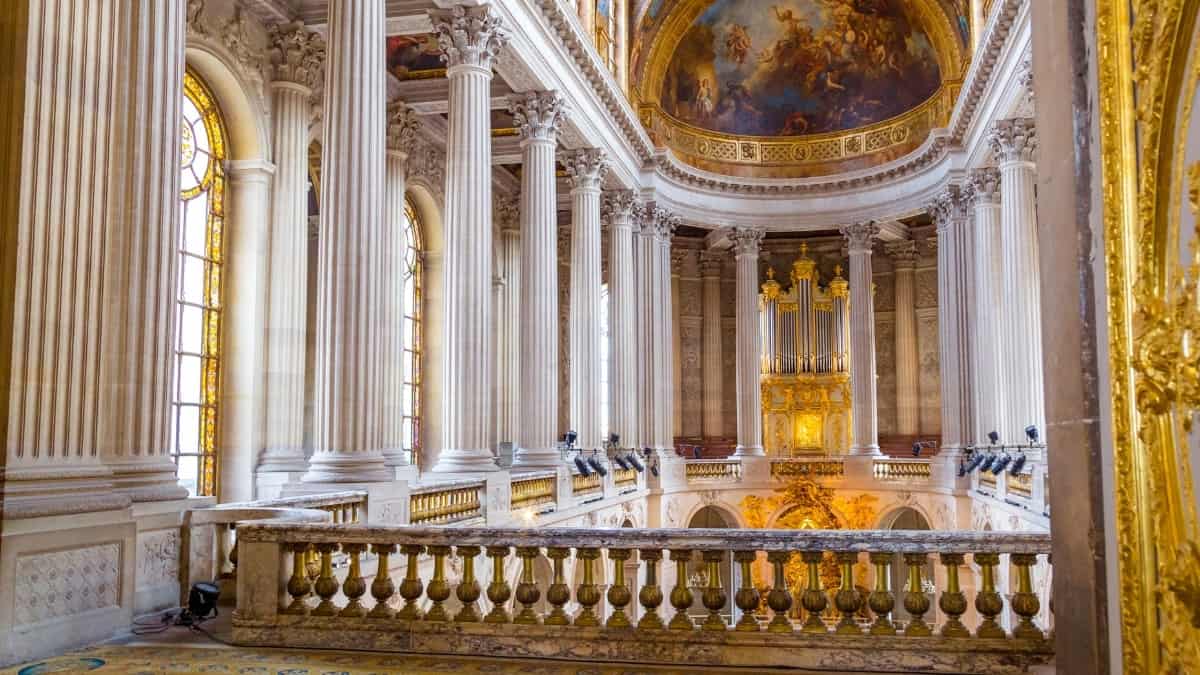
The Palace of Versailles was one of the world’s largest royal residences till the French Revolution in 1789 forced Louis XVI to head for Paris.
At its peak, around 10,000 Royals, aristocrats, and servants lived in the 2,300 rooms inside the Palace of Versailles.
Spread over 63,154 square meters, the most significant achievement in French 17th-century art.
In this article, we share an overview of Versailles Palace interiors, so you know what to expect when you visit the Palace.
Table of Contents
Layout of Versailles Estate
The Versailles Estate is spread over 800 hectares and consists of three sections – Palace of Versailles, Versailles Gardens, and Trianon Estate.
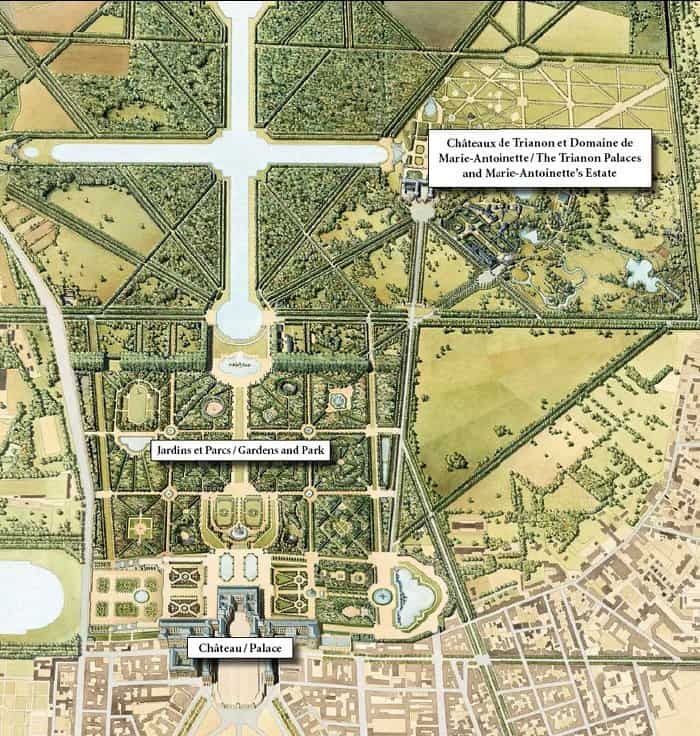
Visitors on short tours explore the Palace of Versailles, take a stroll around the gardens, and get back to Paris.
Visitors on a day-long visit to Versailles have time to explore the Estate of Trianon as well.
The Estate of Trianon was an intimate space built by the Kings to escape from the palace’s courtly etiquette.
It consists of two small palaces – Grand Trianon and Petit Trianon, Queen’s Hamlet, and many ornamental gardens.
Since the attraction is 20 Kms (12 Miles) outside Paris, most visitors book bus or train tours to reach Palace of Versailles.
What to see in Palace of Versailles
There is a lot to see inside the Palace of Versailles.
Most of the visitors spend 2 to 3 hours exploring the interiors of the extravagant French Palace.
If you don’t plan to book a guided tour of Versailles, remember to pick up the free audio guide at the entrance. It explains each of the rooms in great detail.
During the summer months, the Palace gets exceptionally crowded, so being aware of what rooms to see and what to miss helps.
Here is a list of what to expect inside the Palace of Versailles –
Visual Story: 14 must-know tips before visiting Palace of Versailles
Hall of Mirrors
The Hall of Mirrors, the most famous room in the Versailles Palace, was built as an afterthought.
It replaced a large terrace and a few rooms from both the King’s and the Queen’s apartments.
Nobody goes inside the Palace of Versailles and walks out without seeing the Hall of Mirrors.
It is perhaps the most beautiful room in the whole world.
The War Room
Master architect Hardouin Mansart started building the War Room in 1678.
Artist Le Brun painted the ceiling, depicting the victories of France.
His paintings paid tribute to the military victories, which led to the peace treaties of Nijmegen.
The decoration of the War Room was over by 1686.
The Peace Room
The Peace Room is exactly symmetrical to the War Room.
Here, artist Le Brun decorated the ceiling with the benefits of peace brought to Europe by France.
Initially, this room was considered part of Queen’s Apartments.
However, with time, this room got added to the suite of State Apartments.
The Gallery of Great Battles
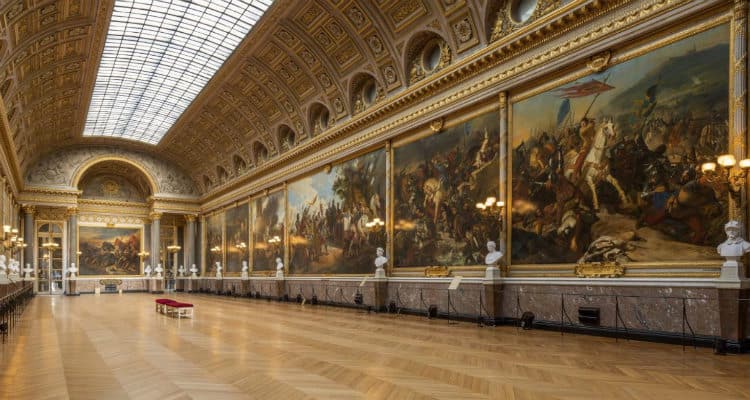
The Gallery of Battles is one of the most power-packed inner rooms of the Palace of Versailles.
It covers almost the entire first floor of the South Wing of the Palace and depicts nearly 15 centuries of French military successes.
The 30 plus paintings decorating the walls of this room, light up the interiors.
Kings State Apartments
This group of seven rooms was used to host the French King’s official ceremonies.
Visitors who wanted to meet the King and his family waited in these rooms.
They could share a word or pass a note as the Royals crossed these rooms on their way to the chapel.
The Hercules Room
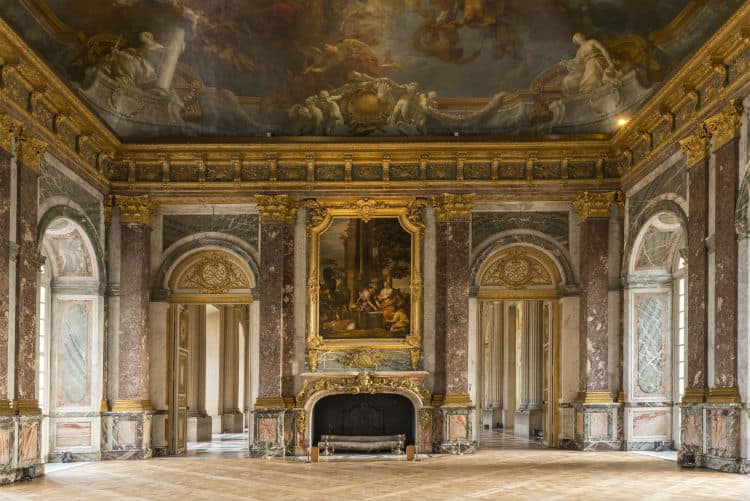
The Hercules Room was the last room to be built by King Louis XIV.
Hercules Room once used to be the Palace Chapel.
While the work on the Hercules Room was over early, the interior decoration wasn’t over until 1736.
François Lemoyne took four years to paint the ceiling depicting The Apotheosis of Hercules.
To give you an idea of the scale of this painting – it has 142 people in it.
The work had taken such a massive toll on Lemoyne that one year later, he committed suicide.
The Hall of Plenty
When the King gathered their courtiers, and other visitors in the State Apartments, Hall of Plenty served as a refreshment room.
There was plenty of coffee, wines, and liqueurs to consume.
Since the King kept his curios in this room, it has often got other nicknames too – Cabinet of Curiosities and Room of Rarities.
The Venus Room
Along with the Diana Room, the Venus Room also acted as one of the main entrances to the State Apartments.
Le Burn painted the ceiling here as well. The interiors of this room light up, thanks to Venus depicted on the roof as the Goddess of Love.
During Evening gatherings, the Venus Room filled the tables with fresh flowers and rare fresh fruits such as oranges and lemons.
The Diana Room
The highlight of this room is the Goddess of the Hunt and the Sister of Apollo on the ceiling.
Like the Venus Room, the Diana room served as a lobby to the State Apartments.
During evening get-togethers with the inner circle, this room doubled up as a Billiards Room.
The Mars Room
The Mars Room marked the start of the King’s Private Apartments.
It was also referred to and used as a Guard Room.
No wonder then, that the interiors of this room are a dedication to the God of war.
On the ceiling of the Mars Room, Claude Audran painted Mars on a chariot pulled by wolves.
When you visit this room, don’t miss out on the cornice.
Since the theme of the room is war, the cornice is decorated with a variety of helmets and military headgear.
The Mercury Room
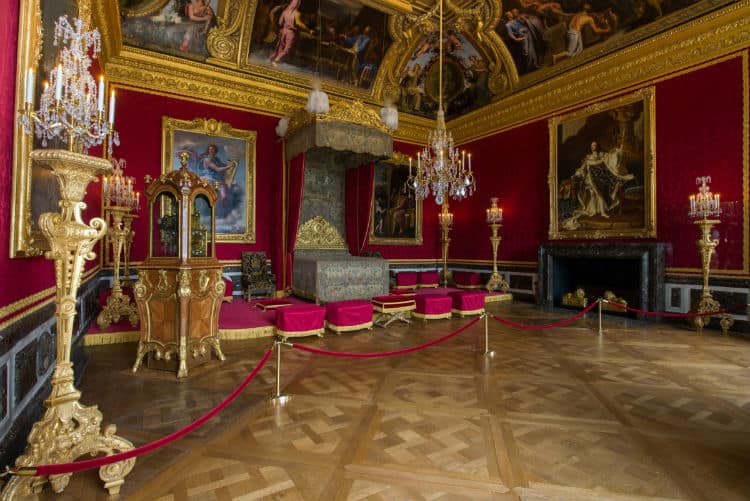
The Mercury Room was also known as the ‘bedroom.’
The interiors of this room in the Palace of Versailles were highly decorated, but Louis XIV had to melt them down to finance the War of the League of Augsburg.
When Louis XIV died, his body was displayed in this room for eight days – from 2 to 10 September 1715.
The Apollo Room
Apollo Room was the sovereign’s Ceremonial Room.
From 1682 onwards, the Apollo Room got used as a throne room.
Since King Louis XIV had adopted the symbol of Sun, this room’s ceiling got dedicated to Apollo, the Sun God.
However, in 1689, Louis XIV’s famous silver throne was melted to pay for a war, and gilded chairs doubled up as thrones.
And the Apollo room stopped being used as the throne room.
The Royal Opera
Architect Ange-Jacques Gabriel designed the Royal Opera, which was inaugurated in 1770.
Even though it was the largest concert hall in Europe (at the time), it was a multi-purpose hall. One could use it as a theatre hall, ballroom, feasting hall, etc.
In its ballroom configuration, it is 45 meters (147 feet) long.
Over the years, it has hosted celebrations, shows, and parliamentary debates.
King’s Bedchamber
The King’s bed-chamber is a massive room in the center of the Palace’s eastern facade.
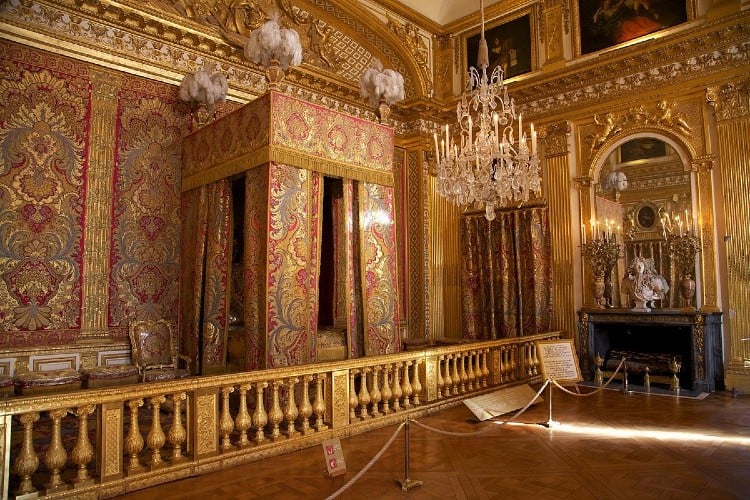
It was used several times of the day, including when the King wanted to dine in private or when he received close courtiers or ambassadors.
The King’s ‘getting up’ and ‘going to bed’ were also ceremonial.
Louis XIV himself chose the four paintings decorating the wall.
The Queen’s Apartments
The Queen’s Apartment is similar in layout to the King’s State Apartment.
Queen’s Apartments consists of the Queen’s Bedchamber, the Nobles’ Room, the Antechamber to the Royal Table, and the Queen’s Guard Room.
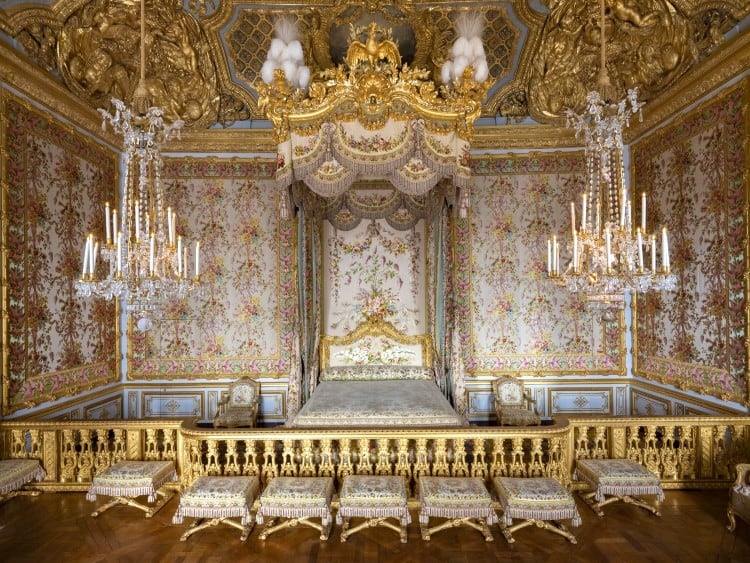
The Bedchamber is the most crucial room in the apartments, and it was here that the Queen spent most of her time.
She slept here, mostly with the King, and met up with her guests during the day.
Marie-Antoinette’s private chambers
Besides her State Apartments, the Queen also had private chambers for her personal use. Queen also invited her ladies-in-waiting to these chambers.
These rooms were decorated with great care and re-decorated many times according to the changes in their occupant’s tastes.
The Royal Chapel
The Royal Chapel standing at Versailles Palace is the fifth one to be built within the premises.
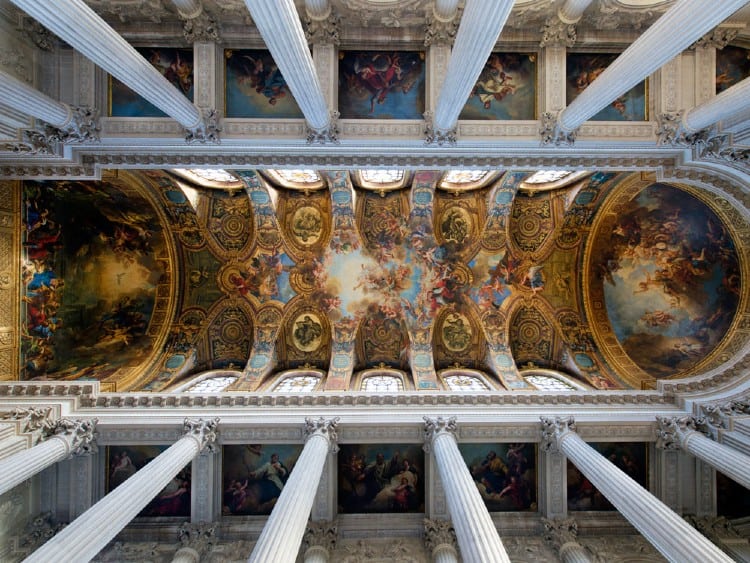
The Chapel is inspired by Gothic architecture and dedicated to Saint Louis, the King’s patron saint.
Every day at 10 am, the Chapel hosted the King’s mass, which was attended by the Royals, the officers, and the general public.
Crusades Rooms
This collection of five rooms narrate the story of eight main crusades between the end of the 11th and the end of the 13th century.
The Crusades Rooms achieve this storytelling through 125 paintings by French master artists such as Delacroix, Granet, Blondel, Larivière, Schnetz, Signol, Odier, etc.
Rhodes Door, a double-leaf door in late Gothic style, dating back to 1512, is one of the most important exhibits in these rooms.
Recommended Reading: History of Palace of Versailles
The Empire Rooms
The 13 Empire rooms are dedicated to Napoleon Bonaparte, who rose to power after the French Revolution.
The Empire Rooms were King Louis-Philippe’s attempt at getting the support of former members of the Empire and the favor of Bonapartist opinion.
After all, he had followed Napoleon I to the throne.
The rooms depict every year and every campaign of the young artillery officer who believed in his ‘lucky star.’
The Coronation Room
In 1833, the King devoted the large space adjoining the royal apartments to the glory of Napoleon Bonaparte.
Over the years, it got the name ‘Coronation Room.’
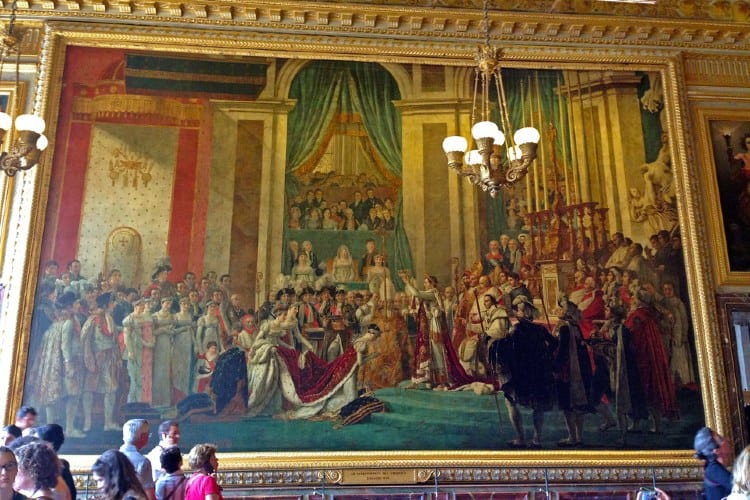
Two massive paintings adorn this room – The Coronation of Napoleon and The Distribution of the Eagle Standards.
The Grand Commun
In 1682, when the French King decided to have his court at Versailles permanently, he needed more servants and secondary officers.
Grand Commun got built to accommodate the additional workforce and today still contains some 17th-century relics.
The six-floor building contained kitchens, dining rooms, apartments, offices, and a chapel.
Recommended Reading: Facts about Palace of Versailles
How to get inside Palace of Versailles
From November to March, on the first Sunday of every month, entry to the Palace of Versailles is free.
All through the year, visitors below 18 years, EU residents under 26 years, school teachers with a pass, and disabled visitors with a carer can enter for free. You need to reach the entrance with a valid ID.
All other visitors must have a Palace of Versailles ticket to enter the Estate.
An audio guide in eleven languages is part of the ticket price.
There are many types of tickets you can choose from –
The cheapest Palace of Versailles ticket costs €20 for an adult (18+ years). It allows you to enter and explore both the Palace and the Gardens.
The most popular Palace of Versailles ticket costs €22 and gets you access to everything in the Versailles Estate – the Palace, the Gardens, and the Trianon Palaces.
The all access ticket including access to Fountain Shows or Musical Gardens, is priced at €59.
The Guided Versailles tour ticket, which gets you an expert local guide to take you around, costs €55 per person.
Versailles tickets + transport from Paris
Since the Palace of Versailles is 20 Kms (12 Miles) outside of Paris, many tourists book tours that include transport both ways.
You can either take a coach tour to Versailles or a train tour. We list our favorite tours from Paris to Versailles –
| Tour type | Transport | Cost |
| Half day, self-guided | Bus | €85 |
| Full day, self-guided | Bus | €75 |
| Full day, guided | Bus | €2100 (group of 8) |
| Half day, guided | Train | €90 |
Get inside Versailles Estate for free
– Passlib is a popular discount card that gets you free travel on Paris trams and Metro and free access to more than 50 attractions.
– Paris Museum Pass is cheaper, but equally effective in saving money.
